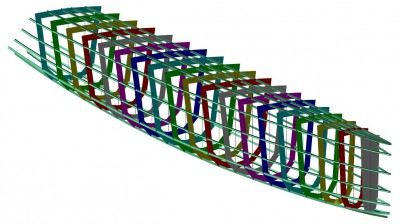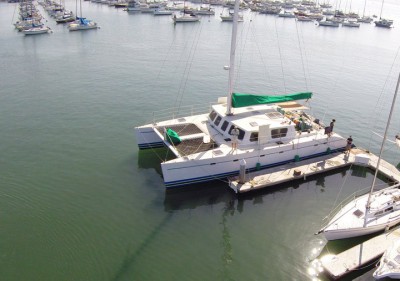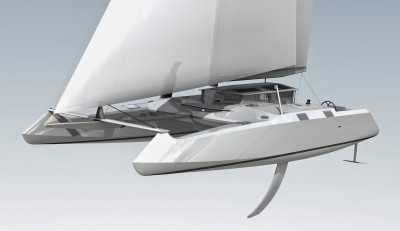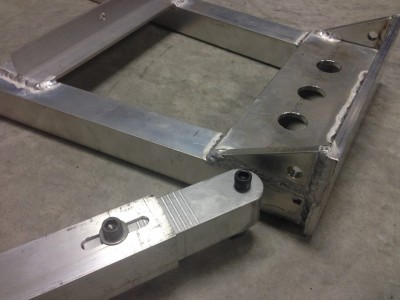I always assume everybody knows that aluminum is not optimimal for efficient small multihulls. I assume here that small is under 60′ length. Still, it keeps coming up again. And Bagalut was sweet.

There are many good reasons not to use aluminum for small multihulls. It starts to make sense when the catamarans are over about 50’ length. Smaller than that, it doesn’t make much sense in standard practice multihulls.
Weight
A typical composite 45’ catamaran in foam/glass would have hulls weighing between 1.1 and 1.3 lbs per square foot of hull. Geoff Strange was doing infused hulls that weighed much less than that even.
The same size aluminum cat would likely have 3/16” thick hulls weighing 2.65 lbs per sqft. Because the aluminum hulls are thinner than foam/glass ones, they need much more frequent internal structure than a composite hull. That adds significantly more weight and work again.
Even compared to an epoxy/plywood hull, again the aluminum is much heavier. A 45’ cat in plywood would typically have a 3/8” (10mm) thick hull that will weigh about 1.2 to 1.4 lbs per sqft.
In a recent study by Horsmon, a pair of nearly identical 135’ fast ferries, one in aluminum and the other composite, were compared The composite version had a bare hull weight of 144,000 lbs or 65,454 kg. The aluminum bare hull to the same rule weighed 226,076 lbs or 102,762 kg. The composite hull had only 64% of the weight of the aluminum one.
Thermal Insulation
Aluminum has very poor thermal insulating properties. Of course composite gives very good insulation. In cold climates the air will easily condense on the aluminum hull causing moisture buildup inside. On a hot day, the metal hull can be like an oven.
The interior can be insulated, but that is another step, as below.
Sound Insulation
Aluminum has very poor sound insulation properties. As expected, composite is an excellent sound insulator.
Interior
The interior of an aluminum hull is a much more complicated project than with a composite one. It will need both stringers and frames. Unlike a composite hull where one has usually 6 or 8 feet of smooth surface, the insulation and maybe even the inside surface has to be fitted into the alloy structure. That covering must allow the aluminum to “breathe” so that it doesn’t set up a crevice corrosion situation.
Unfair surfaces
An alloy hull typically distorts by the process of welding it together. Thinner, lighter hulls or those by a less skilled welder will be much more distorted. I understand that the surface of one of my 65’ daycharter cats in aluminum distorted up to a half inch as a result of the welding.
If the cat is to move well under sail or power, it must have fair hulls. To achieve that, the surface hollows must be filled with microbaloons and sanded. That must then be coated and painted. It’s almost like putting a fiberglass hull over the aluminum hull. Typically, aluminum catamarans now are being built by former fish-boat builders. Hull fairness is not even a concept to them still. The solution to getting enough speed for them is to pile on more power, and they do that. Coming from racing catamarans, we know that only a smooth, fair hull can move easily at faster speeds.
Hull Shape
An alloy hull must have a hard chine shape or be rolled into a rounded shape with a huge metal rolling machine. The hard chine is inconsistent with an easily driven displacement multihull. The rolling device is unavailable to many builders.
Fatigue strength
The fatigue resistance of aluminum is not good. After some 5,000,000 use cycles (maybe 10 years), aluminum strength is about 1/5 of what it was in the beginning. Triaxial glass has about ¼ the strength it started with, but it started much higher. Plywood and carbon fiber will have about half the strength they began with, much better resistance to fatigue.
Ultimate strength
According to ABS, the ultimate tensile strength of a 5000 series alloy will be between 31,000 lb and 42,000 lbs. That is the unwelded strength. The welded strength can be much less depending on alloy used.
A typical good backyard glass laminate will be about 60,000 psi in ultimate flexural strength and probably about 50,000 psi in ultimate tensile strength. Plywood will reach between 10,000 and 18,000 depending on species. The strength of aluminum is not as much as that of composite even though it is heavier.
Toxic bottom paint.
Aluminum hulls cannot be painted with the usual copper based antifouling paint. That paint would rapidly corrode the aluminum hull. Instead, either the very expensive and toxic TBTF (tributln tin) bottom paints must be used, or the hull must be primed with an isolation paint first. The TBTF paints are toxic in parts per billion. Here in Washington state, they must be applied by a registered operator. The average owner cannot apply his own TBTF bottom paint. In many areas those paints are being banned.
Lifetime costs
Corrosion is such a concern, that haulouts and inspections must be regular and the paint surface must be perfectly maintained. The lifetime costs will be higher than a composite boat. Randy Rust did part of article on this in an issue of Workboat. I will dig it up for the details.
Ride
Even if they had the same hull shape, the composite hull affords a better ride.
Horsmon notes“The ride quality of the composite vessel will be superior to the aluminum vessel, although they share identical hull forms, because the composite vessel is compliant. The damping effect of the composite panels absorbs many of the short duration accelerations. These same accelerations are transmitted into the primary structure of an aluminum vessel. By the same token, machinery hull borne vibrations are decreased in composite vessels over stiff metallic construction.
Both shocks from hydrodynamic loading, and machinery initiated vibrations should be minimized in marine vessels to provide a comfortable ride to the passengers and prolong the service life of the vessel, as is evidenced in common fatigue studies.”
Conclusion
In conclusion, for multihulls under perhaps 50’ length, an aluminum vessel is not appropriate.
It will be much heavier. Consequently, it will require much larger rig and engine to achieve the same speed as the same vessel in composite.
It will also require a composite structure to be built both outside of it to achieve the necessary fairness and maybe inside to create a livable space.
Over its lifetime it will cost more than the composite vessel.







